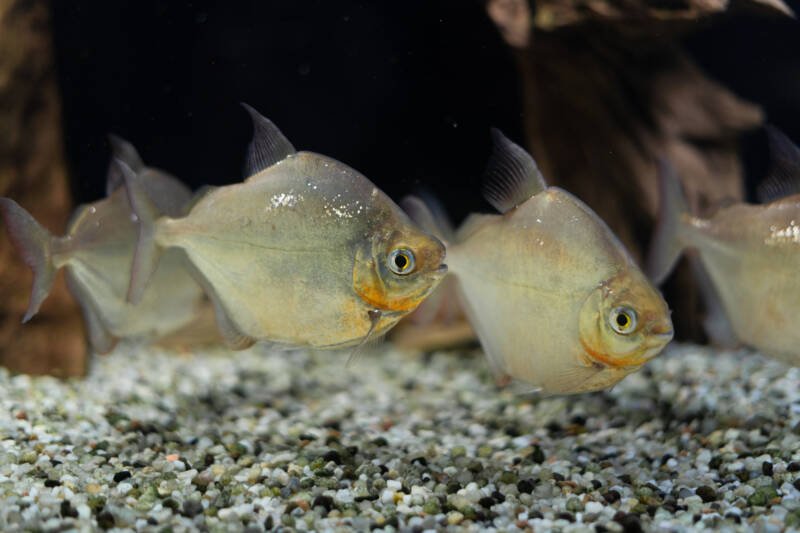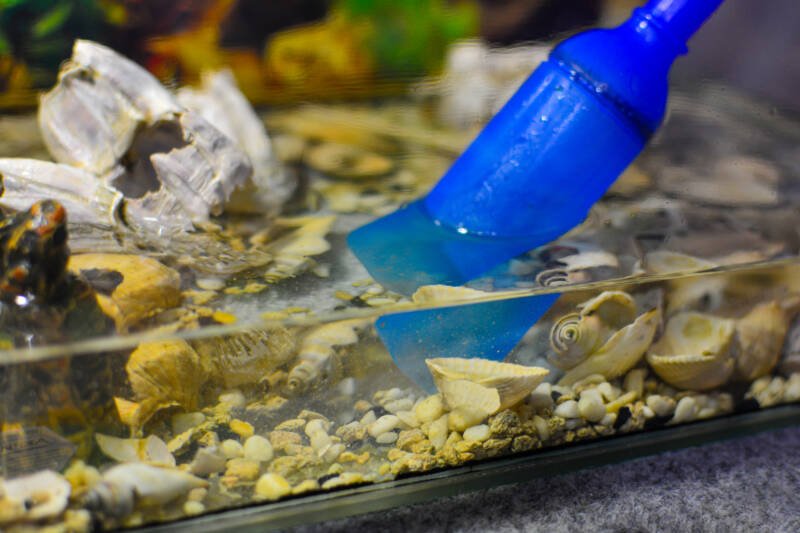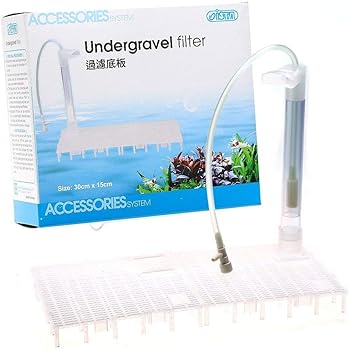The undergravel filter is one of the oldest forms of aquarium filtration. They’ve been used in freshwater and marine aquariums for over 60 years.
If you’re new to the hobby, you may have heard of undergravel filters from old-time aquarists. The truth is undergravel filters (UGFs) work well in certain types of aquariums and not others.
The important thing is to understand how they work and what to expect when you use one in your aquarium.

In this article
What is an undergravel filter?
An undergravel filter is designed to pull aquarium water through the gravel bed, enhancing biological filtration.
Nitrifying bacteria that eliminate harmful fish waste (ammonia and nitrite) live in the upper layers of the gravel. By circulating water through the gravel, the bacteria are able to quickly detoxify fish waste.
How does an undergravel filter work?
An undergravel filter consists of a perforated plastic plate that covers the bottom of the aquarium. It gets covered with aquarium gravel.
Two lift tubes are located at the back of the plate. The clear tube connects to the rear corners of the base plate. Each lift tube contains an air stone.
When air is pumped into the air stones, the rising bubbles pull water through the gravel, up the tube, and out of the spout.
Aquarium water recirculates through the gravel bed several times an hour.
How to set up an undergravel filter
Place the perforated plate on the bottom of the empty tank before gravel is added.
Assemble the plate and uplift tubes first, then add aquarium gravel. The gravel layer should be 1-2 inches deep.
Add the air stones to the uplift tubes. You’ll need an air pump to power the air stones.
Use an air line valve to regulate the amount of air going to each air stone. Once the UGF is set up, add water and decorations.
UGF FAQs
Aquarists have a lot of questions about undergravel filters. Here’s a list of the most popular questions about UGFs.
Do they work in freshwater and saltwater aquariums?
Yes. UGFs work in any aquarium that contains gravel.
How much gravel is recommended?
Use 1-2 inches of gravel. Adding more gravel will restrict the water flow throughout the gravel bed.
Can I use sand?
No. Sand packs too tightly and won’t allow water to flow through the gravel bed.
The sand will also clog the perforated plate on the bottom of the tank.
What size gravel is recommended with an undergravel filter?
The most common aquarium gravel is 0.4”-0.8” in size. This size provides an attractive aquascape and allows water to flow through the gravel.
You can also use the larger pebble-type gravel.
Can I grow plants with an undergravel filter?
Technically yes, but it is not ideal. A planted aquarium is focused on providing the best environment for plants.
Aquatic plants thrive best when grown in small-sized gravel with little water movement in the root area. This creates a low-oxygen zone that duplicates aquatic soils and releases nutrients to the roots.
A planted aquarium will have lots of plants and less fish than a regular fish tank. There is no need for a UGF in a planted aquarium.
Can I use an undergravel filter in a reef aquarium?
No. Most reef tanks do not use gravel. Biological filtration takes place in the live rock. There is no need for a UGF in a reef aquarium.
Undergravel filters work great in saltwater fish tanks and in quarantine aquariums.
Do undergravel filters remove colors and odors?
No. The gravel cannot remove water discoloration or odors from the water.
Some UGFs have a small activated carbon cartridge on each lift tube. As water rises in the tubes, it passes through the activated carbon in the cartridges. These will help keep the water clear and clean.
Will an undergravel filter clear cloudy water?
As aquarium water passes through the gravel bed, small particles of fish waste, uneaten food, dead algae, and other debris will be captured in the gravel.
While this seems like a benefit, it will eventually clog the UGF. Decomposing organic matter will form sludge in-between the gravel particles.
This reduces the water flow and even inhibits the beneficial bacteria living in the gravel.
Should I clean the gravel?

Aquarium gravel contains a variety of helpful microbes. When the gravel gets clogged with sludge, the beneficial microbes have a hard time surviving.
You don’t have to drain the aquarium and wash the gravel to keep it healthy.
Once a month, use a gravel siphon to lighting stir up the gravel and suck out the sludge. It is a great way to clean the gravel and make a water change at the same time.
What size air pump do I need?
You’ll need an air pump powerful enough to create a steady stream of rising bubbles in each lift tube.
If the air pump is weak, it won’t be able to make bubbles to move water through the gravel bed.
Air pumps are usually rated by tank size. Select an air pump slightly larger than you need. This will ensure you have enough air flow to run the UGF.
Use an airline valve to adjust the air flow. You can always bleed off extra air with a valve if necessary. But if your air pump is too small, it won’t be able to drive the UGF.
Do I need to use air stones in the uplift tubes?
Yes. The fine bubbles rising inside the tubes pulls the water into the gravel and up the lift tube.
Big bubbles from an air line won’t create the lift and water movement necessary to run the UGF.
How often should I replace the air stones?
Anyone who has used air stones knows they eventually clog.
This reduces fine bubble output and creates backpressure on the air pump.
To keep the undergravel filter working at its best, replace the air stones every six months.
Other tips for using an undergravel filter
Most aquarists put the air pump under the aquarium. Placing the air pump in the cabinet helps keep it quiet and out of sight.
Don’t forget to install a check valve in between the air pump the uplift tubes.
If the air pump accidentally gets unplugged or there’s a power failure, water could siphon down the airline and out of the air pump. This will drain the aquarium and flood your home.
A check valve prevents the water from back-siphoning in case of power loss.
If you don’t want to use an air pump to run your undergravel filter, you can use powerheads.
Powerheads are small submersible water pumps. They were designed to slip into the uplift tubes and draw water through the gravel.
Powerhead water pumps are much quieter than air pumps and can’t back-siphon. Many powerheads have water flow adjustment so you can dial in the just the right flow rate.
Penn Plax has been manufacturing aquarium products for over 40 years.
This UGF is designed for aquariums in the 40-55-gallon size range.
The filter comes with 4 filter plates (each measuring 11.5″ X 11.5. This UGF uses large 1-inch adjustable-height lift tubes.
This makes it easy to raise and lower the lift tubes to match the height of your aquarium. Air stones are also included in the filter kit.
Lees is a major manufacturer of plastic aquarium accessories.
This undergravel filter uses a one-piece base plate that spans the entire aquarium.
Designed for 125 and 135-gallon aquariums, the sturdy thick plate drops right into a large aquarium.
The kit comes with lift tubes that you can trim to the proper height with a knife.
It also includes activated carbon canisters on top of the lift tubes. You can use the included air stones or switch to powerheads.
The ISTA undergravel filter is designed for smaller aquariums. The base plate measures 11.8″ X 5.9″.
It is a simple, no-frills design that works best for aquariums around five gallons.
It has one lift tube and comes with a plastic diffuser instead of an air stone.
The airline has an airflow valve to reduce the air flow rate if necessary.
Imagitarium is Petco’s branding for aquarium products. This undergravel filter is designed for 29-gallon aquariums.
The filter uses two base plates. Each base plate has an adjustable uplift tube.
Two activated carbon cartridges are included, along with air stones. You can use the air stones or upgrade to a powerhead pump.
Recommendations
Undergravel filters use proven technology to purify aquarium water and keep ammonia and nitrite under control.
While they are sometimes considered “low-tech”, they are reliable and easy to use.
If you’ve got a large aquarium, the Lee’s Premium Undergravel Filter is built to fit into a big tank.
For a small 5-gallon tank, the ISTA undergravel filter is ideal.
For best results, swap out the plastic air stone with a higher-grade porous model. It will produce smaller bubbles and create better water flow.
Penn Plax makes a variety of UGF sizes. You should be able to easily match one for a mid-sized aquarium.
If you have questions or comments, please leave them below.



